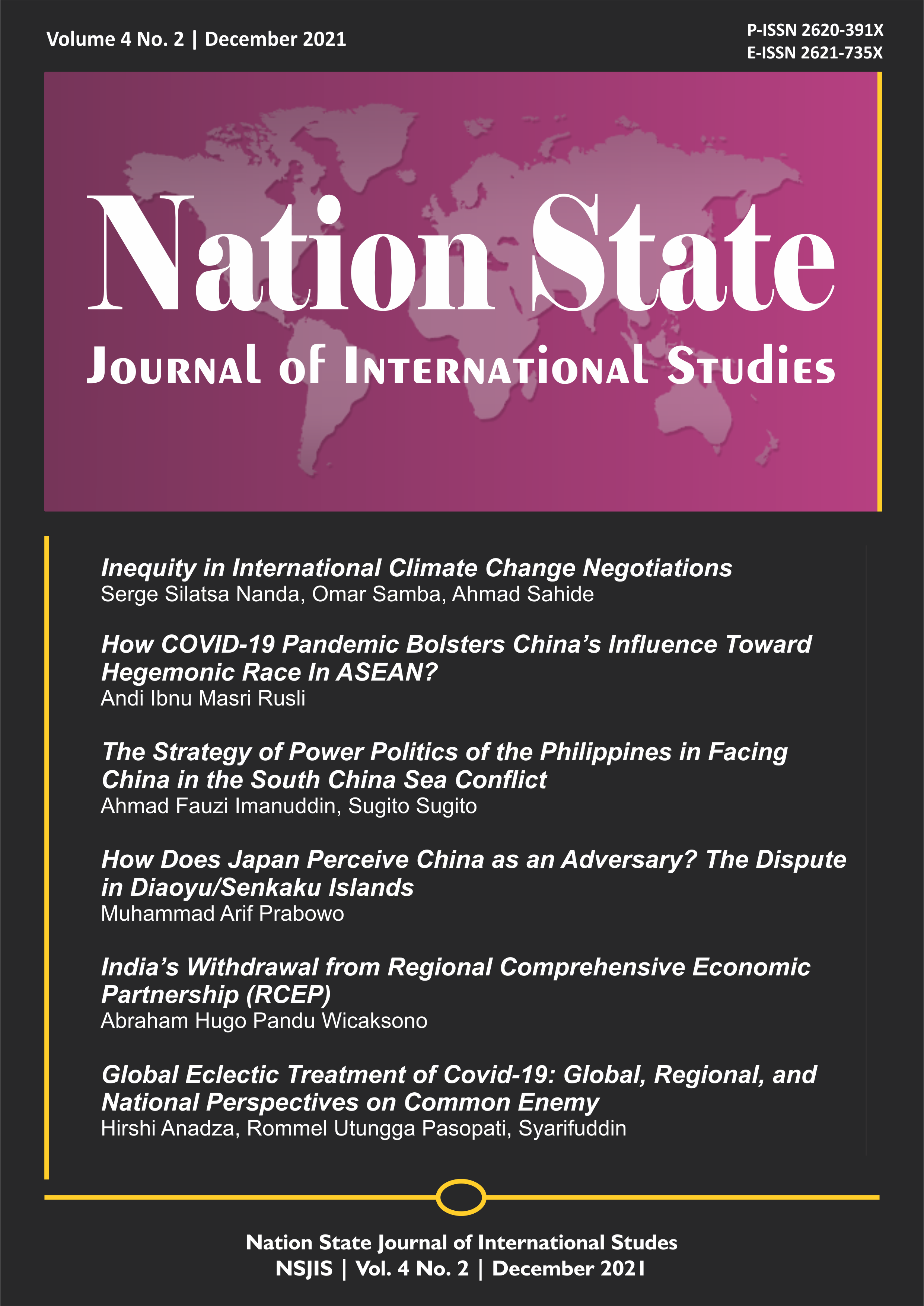How Does Japan Perceive China as an Adversary?
The Dispute in Diaoyu/Senkaku Islands
DOI:
https://doi.org/10.24076/nsjis.v4i2.497Keywords:
China, Japan, Perception, Security, DisputeAbstract
A China-Japan grim relationship has been marked by conflicts, and other political security tensions for a long time. One of which is the Diaoyu/Senkaku islands dispute occurring since 2012, it will become an issue for both countries that is difficult to be ironed out. The dispute has occurred since the Japanese government nationalized the islets, which China also claimed. It led to both countries' expansion of military power and a clash in East Asia. This essay aims to analyze how Japan perceives China by focusing on the Diaoyu/Senkaku islands dispute. This article argues Japan perceives China as a threat due to China’s military penetration over Diaoyu/Senkaku islands leading to a strategic distrust of Japan and its uncertain behavior as an international relations actor led to a moral distrust of Japan. This phenomenon will likely raise the tension in the region and enhance the escalation possibility due to the security dilemma effect.
References
Burke, Edmund J. et al. (2018) China's Military Activities in the East China Sea: Implications for Japan's Air Self-Defense Force (Online). Available at: https://www.rand.org/pubs/research_reports/RR2574.html (Accessed: 17 January 2021).
Cabinet Office Survey. (2019) Public Opinion Poll on Foreign Policy - Opinion Poll Report (Online). Available at: https://www.cao.go.jp/en/news/2019/index.html (Accessed: 18 January 2020).
Chartrand, Benoit H. (2016) “Misperception, Threat Inflation and Mistrust in China-Japan Relations”, Centre for International Governance Innovation. Available at: www.cigionline.org (Accessed: 13 February 2021).
Chen, Shi. (2015) ‘Mutual Distrust between China and Japan and the Locked Sino-Japanese Relations.’ This essay was presented in The Asian Conference on Asian Studies, Osaka, Japan.
Cordesman, Anthony H. and Kendall, Joseph. (2016) Chinese Strategy and Military Modernization in 2016 – A Comparative Analysis. Washington D.C: Center for Strategic and International Studies.
Creswell, John W. & Creswell, J. David. (2018) Research Design Qualitative, Quantitative, and Mixed Methods Approaches. Melbourne: SAGE Publications.
Defense Intelligence Agency. (2018) China Military Power : Modernizing A Force To Fight And Win. Washington D.C: Defense Intelligence Agency.
Garcia, Zenel. (2019) China’s Military Modernization, Japan’s Normalization and the South China Sea Territorial Disputes, New York: Palgrave Macmillan.
He, Yinan. (2020) “Forty Years in Paradox: Post-normalisation Sino-Japanese Relations”, China Perspective, pp.7-16. doi: https://doi.org/10.4000/chinaperspectives.6314.
Heginbotham, Eric and Samuels, Richard J. (2018) A New Military Strategy for Japan: Active Denial Will Increase Security in Northeast Asia (Online). Available at: www.foreignaffairs.com (Accessed: 28 January 2021).
Iriye, Akira. (1990) “Chinese – Japanese Relations: 1945-90”, The China Quarterly, 1(124), pp. 624-638. Doi: http://www.jstor.org/stable/654640.
Japan Ministry of Defense. (2018) Defense of Japan 2018. Tokyo: Ministry of Defense.
Japan-China Relations. (2019) Japan-China Summit Meeting and Dinner (Online). Available at: https://www.mofa.go.jp/a_o/c_m1/cn/page3e_001046.html (Accessed: 28 January 2021 ).
Jervis, Robert. (1978) “Cooperation Under Security Dilemma”, World Politics, 30(2), 167-214. Doi: https://doi.org/10.2307/2009958.
Joint Staff Press Release. (2020) Statistics on scrambles through FY2019 Defense (Online). Available at: https://www.mod.go.jp/js/Press/press2020/press_pdf/p20200409_02.pdf (Accessed: 13 January 2021).
Kantei, Japan. (2013) National Security Strategy (Online). Available at: http://japan.kantei.go.jp (Accessed: 12 January 2021).
Kotler Mindy L. et al. (2007) “Chinese and Japanese Public Opinion: Searching for Moral Security”, Asian Perspective. 31(1), pp. 93 – 125. Doi: http://www.jstor.org/stable/42704578.
Kuroki, Maiko. (2013) Nationalism in Japan’s Contemporary Foreign Policy: A Consideration of the Cases of China, North Korea, and India, Doctoral Thesis, London: London School of Economics and Political Science.
Lee, Ivy and Ming, Fang. (2012) “Deconstructing Japan’s Claim of Sovereignty over the Diaoyu/Senkaku Islands”, The Asia-Pacific Journal. 53(10), pp. 1-49. Available at: https://apjjf.org/2012/10/53/Ivy-Lee/3877/article.html (Accessed: 12 January 2021).
Moore, Gregory J. (2014) “In Your Face”: Domestic Politics, Nationalism, and “Face” in the Sino-Japanese Islands Dispute”, Asian Perspective, 38(2), pp. 219-240. Doi:10.1353/apr.2014.0009.
Oxford University Press. (2020) Structural Realism/Offensive and Defensive Realism. Oxford Research Encyclopedias (Online). Available at: https://oxfordre.com/internationalstudies/view/10.1093/acrefore/9780190846626.001.0001/acrefore-9780190846626-e-304 (Accessed: 2 February 2021).
Pan, Zhongqi. (2007) “Sino-Japanese Dispute over the Diaoyu/Senkaku Islands: The Pending Controversy from the Chinese Perspective”, Journal of Chinese Political Science, 12(1), pp. 71-92. Doi: https://doi.org/10.1007/s11366-007-9002-6.
Rathbun, Brian C. (2009) “It takes all types: social psychology, trust, and the international relations paradigm in our minds”, International Theory, 1(3), pp. 345–380. Doi:10.1017/s1752971909990121.
Rathbun, Brian C. (2009) “It takes all types: social psychology, trust, and the international relations paradigm in our minds”, International Theory, 1(3), pp. 345–380. Doi:10.1017/s1752971909990121.
Stokes, Bruce. (2016) Hostile Neighbors: China vs. Japan – View Each Other As Arrogant, Violent, Disagree on WWII Legacy (Online). Available at: https://www.pewresearch.org/global/2016/09/13/hostile-neighbors-china-vs-japan/ (Accessed: 12 January 2021).
Stronach, Bruce. (1995) Beyond the Rising Sun – Nationalism in Contemporary, London: Praeger Publishers.
Swaine, Michael D. et al. (2013) China’s Military and the U.S. – Japan Alliance in 2030, Washington D.C: Carnegie Endowment for International Peace.
Tang, Shiping. (2009) “The Security Dilemma: A Conceptual Analysis”, Security Studies, 18(3), pp. 587-623. Doi: https://doi.org/10.1080/09636410903133050.
Taylor, Alan. (2012) Anti-Japan Protests in China (Online). Available at: https://www.theatlantic.com/photo/2012/09/anti-japan-protests-in-china/100370/ (Accessed: 18 January 2021).
Tollefson, Julie. (2018) Japan's Article 9 and Japanese Public Opinion: Implications for Japan's Article 9 and Japanese Public Opinion: Implications for Japanese Defense Policy and Security in the Asia Pacific, Magister Thesis. Ohio: Wright State University.
United States Department of Defense. (2019) Annual Report To Congress : Military and Security Developments Involving the People’s Republic of China 2019. Washington D.C: Office of the Secretary of Defense.
Walt, Stephen M.. (1987). The Origins of Alliances, New York: Cornell University Press.
Xuanzun, Liu. (2020) China Slows Defense Budget Growth To 6.6 % In 2020 (Online). Available at: https://www.globaltimes.cn/content/1189146.shtml (Accessed: 3 February 2021).
Yoshihara, Toshi. (2020) Dragon Against The Sun: Chinese Views Of Japanese Seapower, Beijing: CSBA.
Downloads
Published
Issue
Section
License
Copyright (c) 2021 Muhammad Arif Prabowo

This work is licensed under a Creative Commons Attribution-NonCommercial 4.0 International License.


